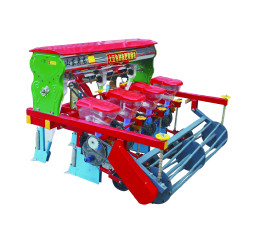- What is the Seed Planter?
A seed planter is a farm equipment attached to a tractor that helps you sow seeds in a proper row and spread them evenly. It is an effective tool that makes your work easier and helps you save precious seed.
Garden seed planters come in many different styles. Two of the most common are walk-behind seed planters and stab planters..png)
- What is the seed planter?
The seed planter is a machine that allows you to put seeds into the ground. It is usually a wheeled device that you push down the garden row.
These types of garden seeders are most useful for planting medium to large size seeds like corn, peas and beans. Some can also be used for planting small seeds such as spinach and broccoli.
Many modern garden planters also have a fertilizer bin where you can add granular fertilizer to the soil before the seed goes into the ground. Some planters have a dual hopper where you can add seeds and fertilizer at the same time.
Some older planters have a coulter that rides behind the seed opener. The coulter helps cut residue and penetrate the soil, allowing the planter to place seed properly.
Ideally, the coulter is mounted ahead of the seed opener on the planter unit. If it is not, the coulter will snag and not cut the soil. This can lead to a bad seedbed and lower crop yields.
Heavier frame planters often use down-pressure springs to transfer weight to the coulters and depth wheels to cut and penetrate the soil. The springs must be adjusted to provide enough down pressure but not too much. Too little pressure results in shallow seed placement and too much down pressure causes the soil to compact near the seed furrow.
- How many types of seed planters?
Seed planters are machines that make a hole in the ground and plant seeds, sometimes in one pass. They’re most useful for bigger plantings of medium-to-large seeds like corn, beans, peas and peanuts.
Some of them also work to meter the seed and get it to a proper depth for germination. Some of them even have a closing wheel that compresses the soil around each seed to improve seed-to-soil contact, which leads to faster germination.
These are a few of the more popular types of seed planters, but there are others available as well. They include walk-behind planters, stab planters and drills.
A walk-behind planter works much like a tractor. It’s made of fiberglass or concrete and can be moved easily.
It also is a long-lasting machine that is easy to use and can be used for many different crops, including both conventional and no-till planting methods.
There are also a few models that work with small seeds, such as lettuce, carrot and endive. These are called single-seed planters and Monosem offers five of them to choose from.
Some of these are also very simple machines that work by simply delivering the seeds into a tube and dropping them into the ground. They’re most useful for gardeners and farmers who want to save their seed..png)
- How do the seed planters work?
A seed planter is a piece of farm equipment that attaches to the back of a tractor and helps farmers sow seeds. This makes it much easier and faster for farmers to sow seeds in a row and spread them evenly.
Generally, a seed planter is a device that uses a chain to push a wheel down a garden row and drop individual seeds into the soil. This is a very common type of garden seed planter, but it also comes in other forms.
There are two types of garden seed planters: a push planter and a jab planter. A push planter has wheels that you can push down a garden row and it controls the planting depth, seed spacing, and number of seeds that are dropped into each hole.
The other type of garden seed planter is a jab planter, which is a tall device that you carry to each planting hole. This is a good option for those who want to plant in hills, or with less square footage to work with.
Regardless of the type of seed planter you choose, it’s important to set the depth of the seed trench according to the condition of the soil. Planting deeper can make germination more successful and allow crops to better use the available moisture in the seedbed.
.png)

 中文
中文 English
English Español
Español Français
Français



